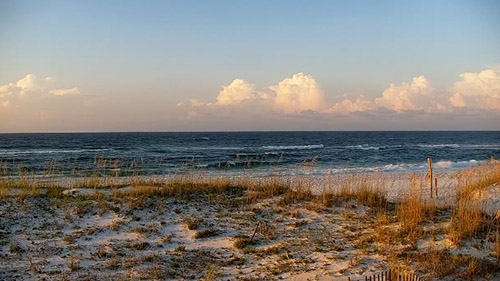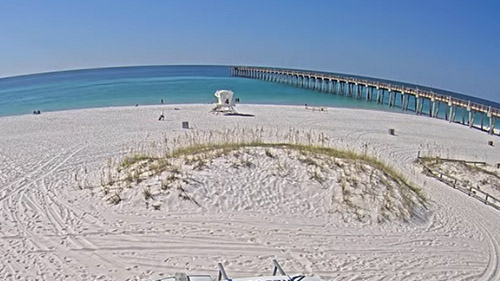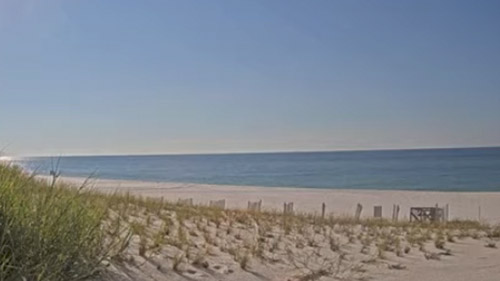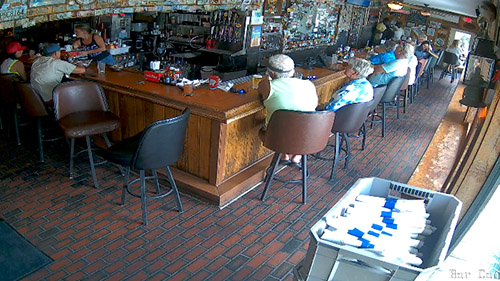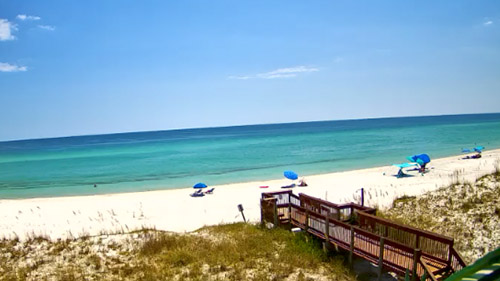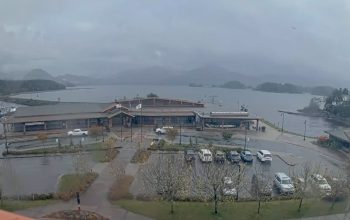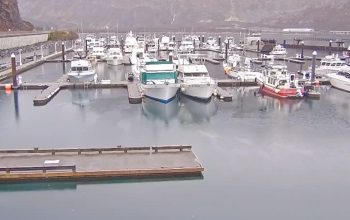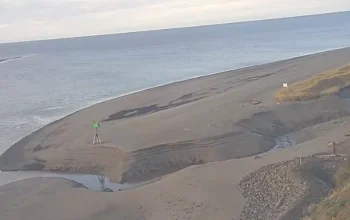Live Pensacola FL Webcams
Pensacola, Florida, is a coastal treasure that offers beautiful beaches, a lively nightlife, and rich history. If you’re planning a visit or simply want to enjoy the views from home, Pensacola FL webcams provide a direct link to the area’s stunning scenery and vibrant energy. These live cams let you feel like you’re right there, sitting on the Gulf of Mexico. From the sandy shores of Pensacola Beach to the action in the city’s bars and protected parks, the webcams give you a front-row seat to everything Pensacola has to offer.
Pensacola Beach Real-Time Views
Pensacola’s beaches are famous for their white sand and emerald-green waters. The live cams bring these stunning landscapes straight to your screen, allowing you to enjoy the beauty of the Gulf Coast anytime.
Best Things to Do in Pensacola, Florida
Pensacola, Florida, known as the “City of Five Flags,” is a Gulf Coast treasure filled with history, outdoor adventures, and cultural experiences. Whether you’re a beach lover, history enthusiast, or foodie, Pensacola has something for everyone. From its stunning white-sand beaches to its lively festivals, here are the top things to do in Pensacola in 2025.
1. Relax on Pensacola’s Beautiful Beaches
Pensacola is famous for its pristine beaches, featuring soft white sand and emerald-green waters.
- Pensacola Beach is perfect for sunbathing, swimming, and beachside dining. Visitors can also rent paddleboards or take a dolphin tour.
- Perdido Key State Park is a quieter option with scenic dunes and plenty of opportunities for birdwatching and fishing.
- Johnson Beach offers a peaceful escape within the Gulf Islands National Seashore, where you can walk along untouched shorelines and enjoy a sunset picnic.
Whether you want a lively atmosphere or a secluded getaway, Pensacola’s beaches are a must-visit.
2. Explore the Historic Pensacola Village
Step back in time at the Historic Pensacola Village, where 19th-century homes, museums, and reenactments bring the past to life. Walk through historic buildings, learn about early Spanish settlements, and tour exhibits covering everything from colonial times to World War II. If you love history, this is a must-see.
3. Tour the National Naval Aviation Museum
One of the top attractions in Pensacola is the National Naval Aviation Museum. This free museum features over 150 restored aircraft, including historic Blue Angels jets. Interactive exhibits, flight simulators, and guided tours make this an exciting stop for all ages. If you’re lucky, you might catch a Blue Angels practice session at the nearby airfield.
4. Walk the Iconic Pensacola Beach Pier
The Pensacola Beach Gulf Pier offers breathtaking views of the Gulf of Mexico. It’s a great spot for fishing, spotting dolphins, or just enjoying a peaceful walk. At sunset, the pier becomes one of the best places in town to snap stunning photos of the horizon.
5. Visit Fort Pickens
Located within the Gulf Islands National Seashore, Fort Pickens is a historic 19th-century fort once used to defend Pensacola Bay. Visitors can explore its tunnels, cannons, and exhibits while learning about its role in the Civil War. The surrounding park offers hiking trails, picnic areas, and scenic views of the coastline.
6. Enjoy Pensacola’s Art and Culture Scene
Art lovers will enjoy the Pensacola Museum of Art, which features contemporary and historical pieces. The city also has a lively theater scene, with performances at the Saenger Theatre and Pensacola Little Theatre.
For a unique experience, visit the Graffiti Bridge, an ever-changing canvas of street art where local artists showcase their creativity.
7. Attend Exciting Festivals and Events
Pensacola’s event calendar is packed with fun festivals throughout the year:
- Pensacon (February): A massive pop culture convention celebrating comics, sci-fi, and gaming.
- Pensacola Crawfish Festival (April): A seafood lover’s dream, featuring live music and delicious crawfish dishes.
- Bands on the Beach (April – October): Weekly beachfront concerts with live music.
- Blue Angels Air Shows (July & November): Watch the U.S. Navy’s flight team perform stunning aerial tricks.
- Great Gulfcoast Arts Festival (November): A celebration of art, music, and local craftsmanship.
No matter when you visit, there’s always something exciting happening in Pensacola.
8. Experience Outdoor Adventures
For nature lovers, Pensacola offers plenty of outdoor activities:
- Big Lagoon State Park is perfect for kayaking, birdwatching, and hiking.
- Bay Bluffs Park has scenic boardwalks overlooking Escambia Bay.
- Adventures Unlimited offers zip-lining and tubing down the Coldwater Creek.
Whether you prefer a relaxing nature walk or a thrilling outdoor adventure, Pensacola has it all.
9. Family-Friendly Activities
Pensacola is a fantastic destination for families. Kids will love:
- The Pensacola MESS Hall, a hands-on science museum with fun experiments.
- The Gulf Breeze Zoo, home to giraffes, zebras, and a safari train ride.
- Sam’s Fun City, an amusement park with go-karts, mini-golf, and water slides.
These attractions offer fun-filled days for children and parents alike.
10. Savor Pensacola’s Food Scene
Pensacola’s culinary scene is packed with fresh seafood, Southern classics, and waterfront dining.
- The Fish House is a local favorite, serving fresh Gulf seafood and their famous “Grits à Ya Ya.”
- Peg Leg Pete’s offers incredible oysters and a laid-back beach vibe.
- McGuire’s Irish Pub is known for its legendary steaks and fun atmosphere.
For dessert, grab a key lime pie from J’s Bakery & Café—a sweet way to end the day!
11. Enjoy Seasonal Holiday Festivities
Visiting Pensacola during the holiday season? Don’t miss:
- Mardi Gras Parades (January – March): Colorful floats, music, and celebrations throughout the city.
- Pensacola Winterfest (December): Holiday lights, themed trolley tours, and Christmas performances downtown.
No matter the season, Pensacola knows how to celebrate!
Pensacola offers a little bit of everything, from stunning beaches and rich history to exciting festivals and outdoor adventures. Whether you’re visiting for a weekend or planning an extended stay, you’ll find plenty to see and do. Start planning your trip today and discover why Pensacola is one of Florida’s most beloved destinations!
The Complete History of Pensacola, Florida
Pensacola, Florida, is one of the most historically rich cities in the United States. Its story begins long before European explorers set foot on its shores. From its indigenous cultures and the first European settlements to its role in major conflicts and its growth into a thriving coastal city, Pensacola has a fascinating past. Let’s take a deep dive into the history of Pensacola, Florida.
1. The Indigenous Peoples of Pensacola
Long before European explorers arrived, the Pensacola area was home to Native Americans. The earliest inhabitants date back thousands of years.
The Pensacola Culture
One of the most significant groups was the Pensacola people, a branch of the Mississippian culture. They built mound complexes, like those found at the Bottle Creek site in present-day Alabama. These mounds served as ceremonial centers and were used for religious and political gatherings.
Another important site was Fort Walton Mound, built around 850 CE. It is located about 40 miles east of Pensacola and was part of a regional Mississippian culture that thrived in the southeastern U.S.
These early Native Americans relied on fishing, hunting, and farming. They traveled by dugout canoes, using Pensacola Bay as a major trade route. The area was rich in natural resources, including seafood, timber, and fertile land for agriculture.
2. Early European Exploration (16th Century)
European contact with Pensacola began in the early 1500s. Spanish and French explorers mapped the Gulf Coast in search of new lands, riches, and trade routes.
- Diego Miruelo (1516) may have been the first European to sail into Pensacola Bay.
- Pánfilo de Narváez (1528) and Hernando de Soto (1539) explored the area while searching for gold and new territories.
- In 1559, Tristán de Luna y Arellano, a Spanish explorer, led an expedition to settle Pensacola Bay.
Tristán de Luna and the First Settlement (1559)
De Luna’s expedition was the first multi-year European settlement in what is now the United States. He brought 1,500 settlers and 11 ships from Mexico, intending to establish a permanent colony.
However, just five weeks after their arrival, a devastating hurricane struck on September 19, 1559. Six ships sank, one was grounded, and the colony’s food supplies were destroyed. The survivors tried to relocate inland but eventually abandoned the settlement in 1561.
This failure discouraged Spanish colonization in the area for more than a century.
3. Spain Returns to Pensacola (1698)
In the late 1600s, European powers were competing for control of North America. Spain saw the strategic importance of Pensacola Bay and decided to re-establish a settlement.
In 1698, Spanish forces under Andrés de Arriola founded the first permanent colony in Pensacola, known as Presidio Santa María de Galve. It included a fort, San Carlos de Austria, which was built near present-day Fort Barrancas.
The Spanish settlers faced many challenges, including:
- Attacks from the French, who had settled in Mobile and New Orleans.
- Conflicts with the Creek and Choctaw groups, who resisted European expansion.
- Disease and hurricanes that made life difficult.
4. The Struggle for Control: Spanish, French, and British Rule
Pensacola changed hands multiple times over the next two centuries due to conflicts between European powers.
French Rule (1719-1722)
- In 1719, the French captured Pensacola during the War of the Quadruple Alliance.
- They burned the Spanish fort and briefly held the city before a hurricane forced them to abandon it in 1722.
- The Spanish returned and rebuilt the settlement, establishing Presidio Isla de Santa Rosa on Santa Rosa Island.
British West Florida (1763-1781)
- After the Seven Years’ War, Spain ceded Pensacola to the British in 1763.
- The British made Pensacola the capital of West Florida and expanded its economy.
- Surveyor Elias Durnford laid out the modern street plan of downtown Pensacola.
- The British strengthened Fort Barrancas and built new fortifications.
Spanish Control Returns (1781-1821)
- During the American Revolution, Spain, led by Bernardo de Gálvez, recaptured Pensacola in 1781.
- Spain ruled Pensacola until 1821, when Florida was transferred to the United States.
5. Florida Becomes Part of the United States (1821)
In 1819, Spain signed the Adams-Onís Treaty, ceding Florida to the United States for $5 million.
Andrew Jackson, the future U.S. president, served as Florida’s first territorial governor in 1821. Pensacola became a key naval port and military base for the U.S.
6. Pensacola in the Civil War (1861-1865)
When Florida seceded from the Union in 1861, Pensacola became an important Confederate stronghold. However, Fort Pickens on Santa Rosa Island remained in Union control throughout the war.
- In October 1861, Confederate forces tried to capture Fort Pickens in the Battle of Santa Rosa Island, but they failed.
- In 1862, Confederate troops abandoned Pensacola, allowing Union forces to take control.
After the war, Pensacola’s economy struggled, but its harbor and lumber industry helped the city recover.
7. Pensacola in the 20th Century
World War I and World War II
- Pensacola became home to Naval Air Station Pensacola in 1914, training naval aviators.
- The base played a crucial role in World War II, training pilots, including the famous Blue Angels flight team.
Civil Rights Movement
- Like much of the South, Pensacola faced racial segregation and civil rights struggles.
- In the 1970s, Pensacola High School experienced race riots as schools desegregated.
Hurricanes and Growth
- Pensacola suffered severe damage from Hurricane Ivan (2004) and Hurricane Katrina (2005).
- Despite setbacks, the city grew as a tourist destination, attracting visitors with its beaches, historic sites, and naval aviation museum.
8. Pensacola Today
Today, Pensacola is a vibrant coastal city known for:
- Its beautiful beaches, attracting millions of tourists.
- The Blue Angels, who perform spectacular air shows.
- The Historic Downtown District, showcasing 300 years of history.
- A thriving arts and culinary scene, making it one of Florida’s cultural gems.
Pensacola’s history is a story of survival, conflict, and resilience. From its Native American roots to its role in European battles, from the Civil War to modern-day tourism, Pensacola has continually evolved.
Today, it stands as one of America’s oldest settlements, offering visitors a blend of rich history, stunning scenery, and cultural diversity. Whether you come for the history, the beaches, or the food, Pensacola remains a fascinating and unforgettable destination.
Geography and Climate
Pensacola, Florida, is a coastal city with a unique geographical location and a humid subtropical climate. Situated on the north side of Pensacola Bay, the city enjoys warm summers, mild winters, and frequent tropical weather events. Its diverse landscape includes beaches, wetlands, and urban areas, making it an attractive destination for residents and visitors alike. Let’s take a closer look at the geography and climate of Pensacola.
Geography of Pensacola
Pensacola is located in the Florida Panhandle, approximately 59 miles east of Mobile, Alabama, and 196 miles west of Tallahassee, the state capital. The city sits at 30°25′16.71″N 87°13′0.89″W, on the north side of Pensacola Bay, which connects to the Gulf of Mexico.
Size and Land Area
According to the United States Census Bureau, Pensacola covers 41.1 square miles, with 22.8 square miles of land and 18.3 square miles of water. Nearly 45% of the city is water, emphasizing its coastal nature. The terrain gently slopes upward from the bay, providing some elevation that helps reduce the impact of storm surges during hurricanes.
Surrounding Areas
While Pensacola itself is relatively small, several unincorporated communities surround the city, often considered part of the greater Pensacola area. These include:
- Goulding
- Ferry Pass
- Ensley
- Bellview
- Myrtle Grove
- Warrington
- West Pensacola
Many residents of these areas use Pensacola mailing addresses but do not fall within the city’s official limits.
Pensacola Bay and Barrier Islands
Pensacola is part of the Emerald Coast, known for its stunning white-sand beaches and turquoise waters. The barrier islands just offshore, including Santa Rosa Island, help protect the city from major storm surges and coastal erosion.
Climate of Pensacola
Pensacola has a humid subtropical climate (Köppen Cfa), meaning it experiences hot, humid summers and mild winters. The city’s coastal location influences its temperature, rainfall, and weather patterns.
Temperature
Pensacola experiences mild winters and long, hot summers.
- Summer (June – August): Highs range from 90-95°F (32-35°C), with warm nights around 75°F (24°C). The humidity makes it feel even hotter.
- Winter (December – February): Highs average around 60°F (16°C), while lows can dip to 40°F (4°C). Freezing temperatures are rare but do occur a few times each winter.
- Spring and Fall: These seasons bring comfortable temperatures, with highs in the 70s and 80s°F (21-30°C) and lower humidity levels.
The highest recorded temperature in Pensacola was 106°F (41°C) on July 14, 1980, while the coldest temperature ever recorded was 5°F (-15°C) on January 21, 1985.
Rainfall and Precipitation
Pensacola is one of the wettest cities in the United States, receiving an average of 68.3 inches (1,740 mm) of rainfall per year.
- Summer is the wettest season, with frequent afternoon thunderstorms.
- July is the rainiest month, averaging 7.89 inches (200 mm).
- May is the driest month, with about 3.9 inches (99 mm) of rainfall.
Pensacola occasionally experiences snow, but it is extremely rare. The last significant snowfall occurred on January 21, 2025, when up to 9.4 inches of snow covered the city.
Severe Weather and Hurricanes
Pensacola’s location on the Gulf of Mexico makes it highly vulnerable to tropical storms and hurricanes. Several major hurricanes have impacted the city, causing significant damage.
Notable Hurricanes in Pensacola’s History
- Hurricane Ivan (2004) – One of the most devastating storms, destroying 10,000 homes and causing over $6 billion in damages. The storm surge wiped out bridges and coastal infrastructure.
- Hurricane Dennis (2005) – Followed closely after Ivan, bringing hurricane-force winds to downtown Pensacola.
- Hurricane Sally (2020) – Caused severe flooding and $29 million in damages to Escambia County.
Pensacola also experiences tornadoes, such as the EF3 tornado on February 23, 2016, which caused major damage.
Environmental Features
Pensacola Bay is part of a complex estuarine system, which includes:
- Escambia Bay
- Santa Rosa Sound
- Perdido Bay
These waters support diverse marine life, including dolphins, sea turtles, and various fish species. The estuaries serve as critical habitats for migratory birds and other wildlife.
Flora and Fauna
The region is home to pine forests, marshes, and coastal dunes, which provide habitats for many species, including:
- Gopher tortoises
- Bald eagles
- Manatees (seasonally)
Pensacola’s parks, such as Big Lagoon State Park, allow visitors to explore the natural beauty of the Gulf Coast.
Pensacola’s geography and climate make it a unique and beautiful place to live and visit. Its location along Pensacola Bay provides breathtaking views and access to the Gulf of Mexico, while its humid subtropical climate brings warm summers and mild winters. Although the city faces hurricanes and heavy rainfall, its stunning beaches, estuaries, and rich biodiversity make it one of Florida’s most treasured coastal destinations. Whether you’re looking to enjoy white-sand beaches, explore natural parks, or experience the city’s rich history, Pensacola offers something for everyone.
The Economy of Pensacola, Florida
Pensacola, Florida, has a diverse economy built on military operations, tourism, healthcare, education, and manufacturing. As one of the most historically significant cities in the Gulf Coast region, Pensacola benefits from its strategic location, strong military presence, and growing tourism industry. The local economy continues to expand, offering job opportunities and attracting new businesses. Let’s take a closer look at the key sectors driving Pensacola’s economy.
1. Military: The Backbone of Pensacola’s Economy
Pensacola is often called “The Cradle of Naval Aviation” because of its long-standing relationship with the U.S. Navy. The Naval Air Station Pensacola (NAS Pensacola), established in 1914, remains the city’s largest employer and a vital part of the local economy.
Naval Air Station Pensacola (NASP)
- Trains thousands of naval aviators each year.
Other Military Installations
- Home to the Blue Angels, the U.S. Navy’s flight demonstration team.
- Houses the National Naval Aviation Museum, one of the largest aviation museums in the world.
- Corry Station, which provides training for the U.S. Navy’s Information Warfare Command.
- Naval Hospital Pensacola, which serves military personnel and their families.
- Army National Guard Units, stationed in Pensacola, contribute to the city’s defense sector.
With thousands of active-duty personnel, veterans, and civilian contractors, the military plays a crucial role in Pensacola’s economy by providing jobs, infrastructure, and federal investment.
2. Tourism: A Major Economic Driver
Pensacola is a top tourist destination, attracting millions of visitors each year. Its beautiful beaches, historical sites, and annual events generate billions of dollars for the local economy.
Beaches and Outdoor Recreation
Pensacola’s white-sand beaches and clear waters make it a hotspot for beachgoers, scuba divers, and fishing enthusiasts. Key attractions include:
- Pensacola Beach, known for its stunning views and lively atmosphere.
- The USS Oriskany, a sunken aircraft carrier that forms an artificial reef for divers.
- Perdido Key State Park, a popular spot for nature lovers.
Festivals and Events
Pensacola hosts several annual events that draw large crowds and boost local businesses:
- Pensacon (February) – A pop culture convention with 25,000+ attendees.
- Pensacola Seafood Festival (September) – A celebration of local cuisine and culture.
- Great Gulfcoast Arts Festival (November) – A major arts event featuring regional and international artists.
- Pensacola Interstate Fair (October) – A traditional fair with rides, games, and entertainment.
Historic Attractions
Pensacola’s rich history brings in history buffs and cultural tourists. Key landmarks include:
- Fort Pickens, a Civil War-era fort.
- Historic Pensacola Village, which showcases colonial-era buildings.
- Vietnam Veterans’ Wall South, honoring military service members.
With a strong tourism industry, Pensacola benefits from hotel bookings, restaurant sales, and retail spending, making it one of the city’s largest economic sectors.
3. Healthcare and Education: Growing Sectors
Healthcare Industry
Pensacola serves as a regional healthcare hub, providing medical services to residents in northwest Florida and southern Alabama. Major hospitals and medical centers include:
- Baptist Hospital
- Ascension Sacred Heart Hospital
- West Florida Hospital
These facilities offer thousands of jobs in nursing, administration, and medical research.
Higher Education
Pensacola is home to several colleges and universities, contributing to workforce development and economic growth.
- University of West Florida (UWF) – A major university offering degrees in business, engineering, and healthcare.
- Pensacola State College (PSC) – A leading community college providing technical training and associate degrees.
Both institutions help train local professionals, supporting job growth in healthcare, education, and technology.
4. Manufacturing and Aerospace
Pensacola has a growing manufacturing industry, particularly in the aerospace and defense sectors.
ST Engineering Aerospace
- Operates a large aircraft maintenance facility at Pensacola International Airport.
- Brings high-paying jobs in engineering, aviation maintenance, and manufacturing.
Other Manufacturing Companies
- International Paper, which produces paper and packaging products.
- Ascend Performance Materials, a major chemical and fiber manufacturer.
These industries provide steady employment and boost exports, contributing to Pensacola’s economic stability.
5. Retail and Small Businesses
Pensacola’s economy is supported by local businesses, shopping centers, and commercial districts.
Retail and Shopping Hubs
- Cordova Mall, the largest shopping center in the area.
- Downtown Pensacola, filled with unique shops, restaurants, and local businesses.
- Navy Exchange and Commissary, serving military families.
Pensacola also encourages entrepreneurship, with business incubators and startup support programs helping small businesses thrive.
6. Real Estate and Construction
Pensacola’s real estate market has grown steadily, driven by:
- Population growth from retirees and military personnel.
- New developments, including luxury condominiums and commercial properties.
- Hurricane recovery efforts, which lead to rebuilding and infrastructure improvements.
With a booming housing market, construction and real estate contribute significantly to Pensacola’s economy.
7. Transportation and Logistics
Pensacola’s strategic location on the Gulf Coast makes it a key center for transportation and trade.
Major Transportation Hubs
- Pensacola International Airport (PNS) – Provides domestic flights and cargo transport.
- Port of Pensacola – Supports shipping and logistics industries.
- Interstate 10 and Highway 98 – Connects Pensacola to major cities in Florida and beyond.
These transportation networks facilitate business growth and attract investment.
Pensacola’s economy is strong and diverse, with major contributions from military operations, tourism, healthcare, education, manufacturing, and retail. The city continues to grow, attracting new businesses, investors, and residents. With a thriving workforce, expanding industries, and a rich cultural heritage, Pensacola remains one of Florida’s most economically vibrant cities.
